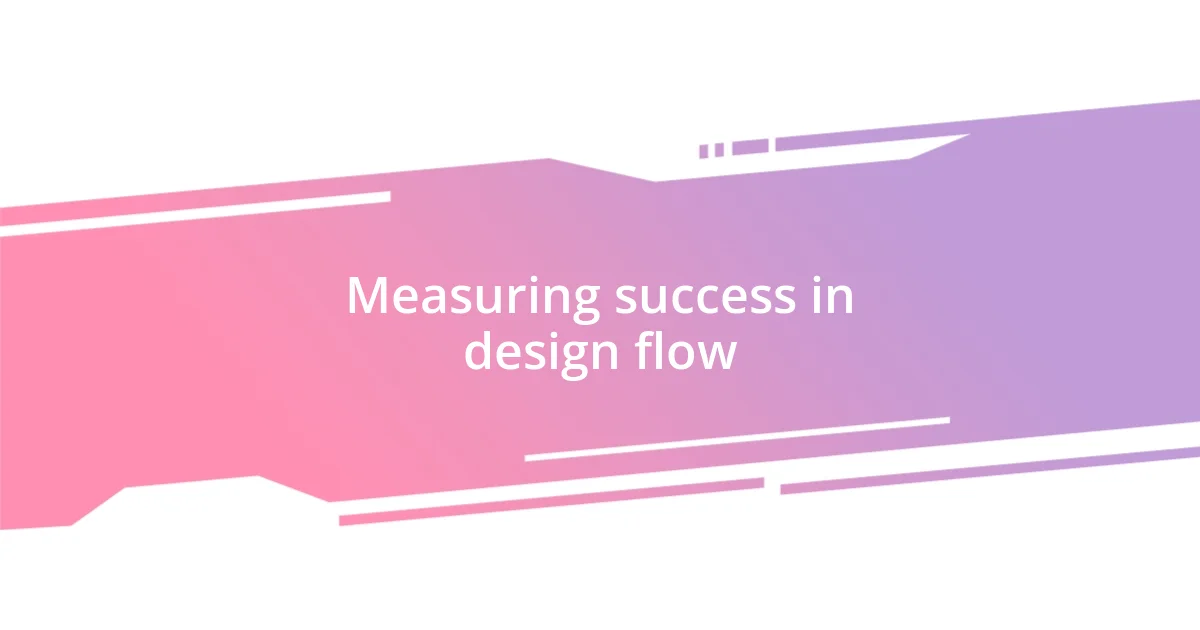Key takeaways:
- Cohesive design flow enhances user experience by ensuring seamless navigation and visual storytelling, highlighting the need for intentional design choices.
- Key principles for cohesive design include consistency, hierarchy, proximity, alignment, and effective use of white space to create a unified and inviting space.
- Measuring success involves tracking user engagement metrics and gathering qualitative feedback, along with setting benchmarks for continuous improvement in design flow.

Understanding cohesive design flow
Cohesive design flow is about creating a seamless experience that guides users effortlessly from one element to another. I remember the first time I nailed a design project; my client mentioned how “natural” the navigation felt. That comment struck me—it highlighted the importance of intention in every design choice.
When I think of cohesive design flow, I see it as a visual story that unfolds, engaging the user at every turn. Have you ever felt lost in a beautifully designed website? It’s frustrating, right? That’s often a result of poor flow, where elements compete for attention rather than complement each other.
Establishing this flow requires attention to detail and a deep understanding of both visual hierarchy and user behavior. For instance, I once redesigned a landing page that had clutter everywhere. After simplifying the layout and ensuring the colors harmonized, I received feedback that visitors felt “invited” instead of overwhelmed. It was a reminder that cohesion isn’t just aesthetic; it’s about crafting a welcoming space for interaction.

Key principles of cohesive design
When I consider the key principles of cohesive design, I can’t help but reflect on how crucial consistency is. I learned this the hard way on a branding project where my initial color choices were all over the map. The moment I settled on a coherent palette, everything clicked into place. Suddenly, the design felt more unified and intentional.
Here are some essential principles to remember for achieving cohesive design:
- Consistency: Use uniform colors, fonts, and styles across all elements to reinforce brand identity.
- Hierarchy: Establish a clear structure that guides users through the content naturally, prioritizing key information.
- Proximity: Group related items to create visual relationships, helping users make connections without confusion.
- Alignment: Ensure elements are aligned correctly; it brings organization and clarity to the overall design.
- White Space: Embrace negative space to prevent clutter while allowing the content to breathe—this is often where the magic happens.
In my experience, practicing these principles transforms chaotic designs into visually compelling narratives that resonate with users. It’s about creating a space where everything has its rightful place, just like in a well-orchestrated symphony.

Steps to achieve cohesive design
Achieving cohesive design isn’t just a checklist; it’s a journey filled with exploration. One vital step is conducting thorough research to understand your audience and their needs. I recall a time when I surveyed users about their experience with a product’s interface. The feedback was eye-opening—it revealed crucial pain points that influenced my design decisions. By aligning my choices with user expectations, I found that the design not only improved aesthetically but also became far more functional and enjoyable for the users.
Next, I strongly advocate for developing a design system. This involves creating a library of reusable components, such as buttons and icons, that maintain a consistent style. In one of my projects, I faced the challenge of redesigning a complex application. By building a design system, I streamlined the workflow, ensuring every team member was on the same page. The result? A seamless user experience where each element felt like a natural part of the whole.
Lastly, don’t underestimate the importance of feedback loops. This means iterating on designs based on user interactions and testing. After releasing a website I had poured my heart into, I was devastated to hear that some users found it confusing. However, instead of giving up, I embraced their feedback. I made adjustments based on their experience, resulting in a design that truly resonated with users and embodied a cohesive flow.
| Step | Description |
|---|---|
| Research | Understanding user needs and behavior to inform design decisions. |
| Design System | Creating reusable components to maintain consistency across designs. |
| Feedback Loops | Iterating design based on user interactions for targeted improvements. |

Common mistakes to avoid
When crafting cohesive designs, one common mistake I often see is neglecting the importance of consistency. I remember a project where I used different font styles for headers and paragraphs, thinking it added variety. Instead, it confused users and diluted the message. Consistency isn’t just about aesthetics—it reinforces your brand identity. Have you ever noticed how a well-known brand’s designs always feel familiar? That’s the power of cohesion at work.
Another pitfall is failing to establish a clear hierarchy. I learned this lesson while developing a website for a local nonprofit. Initially, all pieces of information seemed equally important, making navigation overwhelming. By prioritizing content based on user needs and goals, I transformed the experience. It’s fascinating how a simple adjustment, like changing text size or color, can guide users effortlessly through your design.
Lastly, many designers overlook the necessity of white space, cramming too much into a small area. I once launched a flyer filled to the brim with information, only to hear feedback that people found it daunting. By allowing elements to breathe, I discovered that the message became far more impactful. This space encourages the audience to engage without feeling overwhelmed—think about that next time you’re designing!

Measuring success in design flow
Measuring success in design flow can feel elusive, yet it’s vital. I once launched a project where success wasn’t just about aesthetics or functionality—it was about user engagement. Tracking metrics like user retention and interaction rates gave me a clearer picture of how my design resonated. For example, seeing a 50% increase in daily active users after applying feedback from usability tests was incredibly gratifying.
Beyond quantitative data, I find qualitative feedback equally crucial. During a recent redesign, I implemented user interviews to gather insights on emotional responses to the interface. One user shared that the navigation felt “like a chill breeze on a hot day.” That kind of metaphor not only melted my heart but also validated that my approach was creating a positive user experience. How often do we stop to listen to the stories behind the metrics?
Also, creating benchmarks for design flow is something I prioritize. When I set specific goals, like reducing page load time or improving task completion rates, it gives me a target to aim for. After refining a client’s website, I documented a significant drop in bounce rates. It’s these tangible outcomes that truly measure the success of my cohesive design efforts. It’s captivating how visibility into user behavior can guide us to make impactful design choices.














